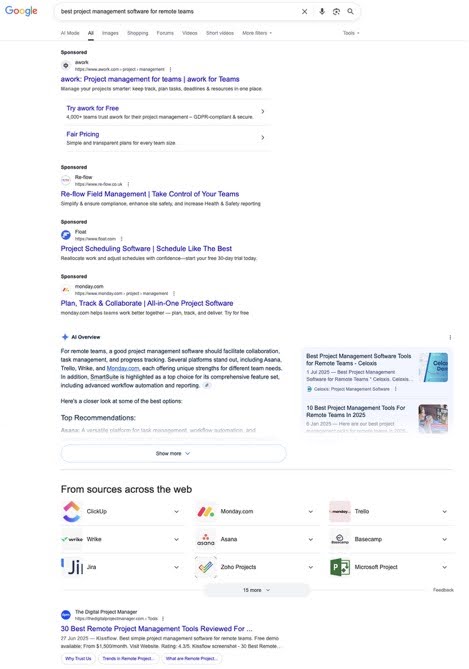
Why smart marketers are adding GEO to their SEO strategy (not replacing it)
Let’s clear something up right away: SEO isn’t dead. That long list of blue links on the Search Results page aren’t disappearing any time soon. But they are increasingly sharing space with something new, in the form of AI generated responses. The rise of AI search doesn’t kill SEO, rather it expands it and most of us are still trying to figure out how to optimise for both. As Google’s own Danny Sullivan recently said, “good SEO is good GEO”.
Google still predominantly controls search traffic. Traditional organic results are alive and well. But ChatGPT now handles 9% of all digital queries. Meanwhile, when Google’s AI Overviews appear, they’re sitting right at the top of those familiar search results.
The new search results page reality
Open Google and search for something complex like “best project management software for remote team.” You’ll likely see:
- Traditional ads
- An AI Overview (synthesising multiple sources)
- Those familiar blue links we know and love
- More ads…

The AI Overview doesn’t replace the organic results but it does sit above them. In this way, it captures attention and sometimes answers the question well enough that users don’t scroll down or click through, resulting in a new era of ‘zero-click search’.
The smart play isn’t choosing between traditional SEO and AI optimisation. It’s doing both.
Introducing GEO: the missing piece of your search strategy
Generative Engine Optimisation (GEO) is the practice of optimising content to appear in AI-generated answers across large language models like ChatGPT, Google’s AI Overviews, Perplexity, and other AI platforms.
Think of GEO as SEO’s strategic partner, not its replacement. While SEO gets you found in traditional search results, GEO gets you cited in AI-powered recommendations.
Why your SEO foundation matters more than ever
There is a common misunderstanding that AI systems are crawling the web independently to find answers. The reality is fundamentally different: they are leveraging existing search infrastructures to retrieve and synthesise information. ChatGPT primarily uses Bing, Claude uses Google, and Perplexity operates as a hybrid of Bing and its own search capabilities.
This means your established SEO strategy isn’t obsolete; it’s actually the foundation of effective GEO. When an AI system needs to provide current information or verify facts, it queries search engines and processes the results that your SEO efforts have made discoverable. Well-optimised content that ranks highly in traditional search results has a significantly better chance of being selected, processed, and included in AI-generated responses. The brands appearing in AI answers are those that already rank well in traditional search results.
The bridge between SEO and GEO isn’t a replacement, it’s an evolution. Your keyword research, technical SEO, content quality signals, and authority building remain valuable because they determine whether your content appears in the search results that AI systems analyse. A well-formed SEO strategy gets you approximately halfway to an effective GEO strategy, providing the visibility foundation that generative systems depend on.
But this also means thinking beyond just Google optimisation. If your audience frequently uses ChatGPT, your Bing performance becomes critical. If they prefer Claude, your Google rankings matter most. Understanding where your audience asks their questions determines which search foundations you need to strengthen.
How AI search changes the optimisation game
Traditional SEO and GEO overlap significantly, as both care about quality content, technical excellence, and authority (remember E.E.A.T.?). But AI search introduces new considerations:
Query Fan-Out: “Query Fan-Out” refers to the process of distributing a query across multiple systems or services to gather data from several sources simultaneously. When someone asks an AI a complex question, it breaks that question into multiple sub-queries and searches for different pieces simultaneously.
Ask “What’s the best CRM for a growing startup?” and the AI might search for pricing comparisons, use cases, integrations, and scalability factors all at once. Your content needs to address the full scope, not just one keyword.
Conversational Queries: People talk to AI differently than they search Google. Instead of “email marketing tools,” they ask “Which email platform can handle complex automation without breaking our budget?”
Passage-Level Relevance: AI doesn’t just evaluate whole pages. It looks at individual sections to pull the most relevant information. Your content needs to work both as a cohesive piece and as standalone chunks.
Content structure drives AI inclusion
The way you structure and write content fundamentally changes how likely AI systems are to cite you. Traditional marketing copy that focuses on vague claims using the first person plural, like “we are industry-leading experts”, means nothing to AI systems looking for specific, contextual information.
Instead, AI favours content that includes:
- Specific brand names and concrete details
- Natural, conversational language that mirrors how people actually ask questions
- Clear, structured information that can stand alone as passage-level answers
- Factual statements with context rather than marketing superlatives
For example, instead of writing “Our platform is the most innovative solution for customer relationship management,” write “Salesforce has been helping companies manage customer relationships since 1999, with over 150,000 customers using its cloud-based CRM platform.” The second version gives AI systems concrete information they can work with and cite confidently.
The goal is creating content that serves as a reliable, structured information source that AI systems can confidently reference and cite. When your content consistently provides clear, well-organised information with proper brand attribution, you increase the likelihood of inclusion across multiple generative AI platforms.
The authority signal shift
Traditional SEO obsesses over backlinks, such as who is linking to you and how authoritative those sites are. GEO flips this priority.
AI platforms care more about mentions than links. If your brand appears frequently in high-quality, context-rich content across the web, you’re more likely to surface in AI answers.
This doesn’t make backlinks irrelevant for SEO. But for GEO, this signals the re-emergence of traditional earned media strategies. The brands succeeding in AI search are those investing in genuine thought leadership, industry expertise, and authentic relationship building to earn organic mentions across quality sources – the foundational PR work that builds real authority rather than manufactured signals.
The strategic dual approach
The potential winning strategy? We believe it’s a proportionate split between traditional SEO and GEO optimisation.
Here’s what we’ve observed with B2B brands who embrace both SEO and GEO:
- SEO continues delivering: Traditional search traffic remains strong
- GEO builds brand authority: AI citations build awareness and credibility (as long as they define you the way you want)
- Compound effects: Content optimised for comprehensive topic coverage helps with both traditional rankings and AI citations
- Future-proofing: You’re established as an authoritative source before competitors catch up
Why most brands are missing this opportunity
Here’s the uncomfortable truth: most brands are either ignoring AI search entirely or claiming they’ve “figured it out.”
AI platforms evolve constantly. What works today might be irrelevant next month. The agencies succeeding aren’t the ones with magic formulas. Rather, they are the ones building robust testing frameworks to experiment, measure, and adapt quickly.
Our agile measurement framework
We’re still in the early days of AI search, which is why we’ve built a solid measurement framework that enables us to be agile and continually iterate our approach.
Traditional SEO metrics remain important, whether that’s rankings, traffic, conversions. But we’ve added new GEO metrics:
- AI citation frequency: How often you appear in AI-generated responses
- Brand mention sentiment: How AI platforms describe your brand
- Prompt ownership: Performance on conversational queries
- Share of voice: Your presence across different AI platforms
This dual measurement approach means marketers who start building integrated SEO/GEO strategies now will have a significant advantage as AI search continues growing.
The goal isn’t to choose between traditional search and AI search. It’s to win at both.
Curious about how your brand performs in both traditional search and AI platforms? At Archetype, we’ve been developing dual SEO/GEO strategies for clients across various industries. Get in touch and see how we can help you win both!



